This is a guest post written by Ella Kay.
It doesn’t take too long to notice to notice the ‘Pop-up Radwege’ peppered around covid-era Berlin. The rationale is straightforward enough and based squarely on the pandemic narrative – provide enough space for people to travel to where they need to go while minimising the risk of infection. At the same time, take pressure off public transport (and enable social distancing for users), and enhance wellbeing through encouraging activity in fresh air.
The first pop-up radweg was established on 25 March 2020, within weeks of an escalating global pandemic. Since then, dozens have emerged in Berlin as well as other German cities. The temporary nature of pop-up radwege has been on a bit of a sliding scale – first until the end of May 2020, then until the end of 2020, and now well into 2021. This ‘temporary’ quality is intentionally low cost, with a per kilometre cost average in Berlin of €9500 (about NZD$16,000). This brings the added benefit of using low-cost measures to test public sentiment before investing in costlier permanent measures.
Developing guidelines and approach
While responsibility for the ordinance relating to containing Covid-19 sits at the state level with the Senate for Environment, Transport and Climate Protection, districts retain the role of implementation of the measures. The Friedrichshain-Kreuzberg district was the first to implement pop-up radwege, and did not hesitate to shape up some general guidelines in doing so. First, and quite importantly – a ten day timeframe for execution is recommended. This includes the identification of a corridor, incorporation of involved authorities, arrangement of the treatments and set up of temporary signage. Some key principles inform the design:
- Physical separation: pedestrians, cyclists/active modes and cars should be separated – including minimising crossings (left/right turn) of cars into adjacent streets.
- Verzeihende Infrastruktur (‘forgiving infrastructure’): minimise the risk of injury through the use of safety clearances (buffer zones) or separation elements.
- Predictability: Routes should be easily understandable and less complex.
- Network approach: Corridors should complement other parts of the network (and may relieve other corridors or sections).


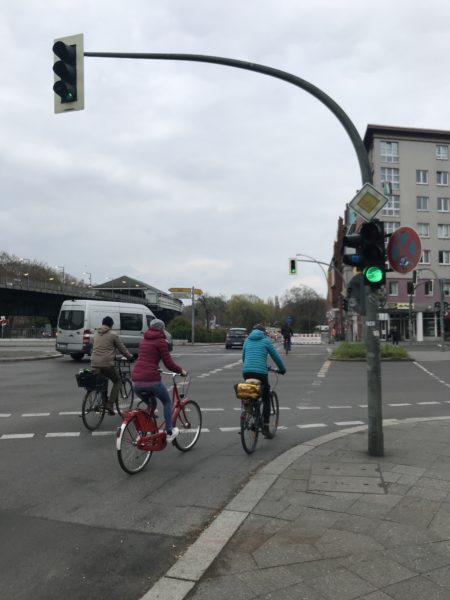
What has surprised me is the bold amount of road space that has been reallocated through this scheme. The segments that I have seen are on typically arterial urban routes that may have had at least two lanes of traffic on both sides, and possibly parking along one or both sides. It isn’t just a measly 1 m or 1.5 m provision squashed into the corridor in a way that retains the existing vehicle capacity – it is actually a full lane (about 3m) on each side handed over to cyclists and active mode users.
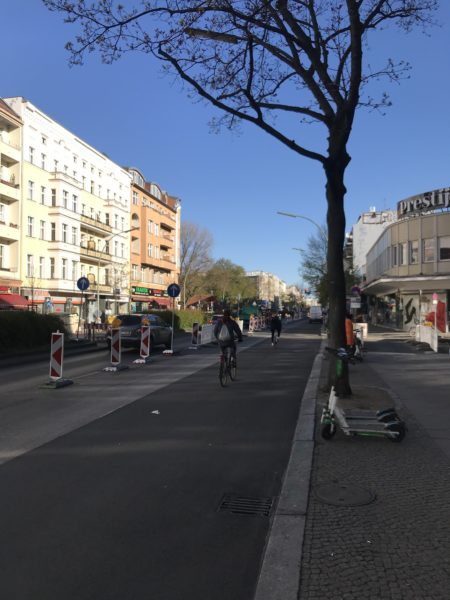
Furthermore, several left/right hand turns into adjacent streets are now closed in order to minimise conflicts. I imagine this has quite an impact on how easily vehicle users are able to get to where it is that they are going.

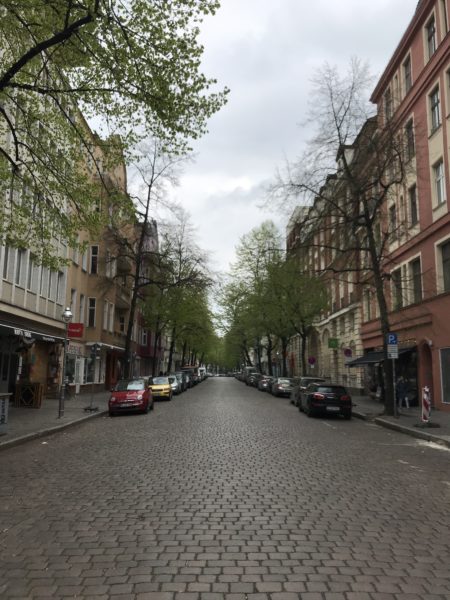
The concept hasn’t been without some controversy. A lawsuit was filed in June 2020 questioning the legal basis of decisions to implement (at that stage) 8 pop-up radwege in Berlin without any reference or reasoning as to why those locations had been selected (e.g. real or perceived safety risks). The second prong of the argument was that the emergency grounds based on the advent of Covid-19 did not have a sufficient line of sight to technical transport or traffic assessments of the corridors. The case was at first upheld but then later dropped when the Senate for Environment, Transport and Climate Protection presented evidence to support determination of the identified corridors. As a result, it looks like the question about the legality of emergency transport or street measures in response to a pandemic remains outstanding.
So, how do the measures become permanent?
While I’ve read that the plan is to transfer the treatments from temporary to permanent measures, my understanding is that this step is governed by the Berlin Mobility Act (rather than the Covid-19 ordinances) and requires formal issuance by the roading authority (i.e. the Senate for Environment, Transport and Climate Protection) which triggers a formal hearing procedure. In several cases the corridors that have been treated already formed identified routes as part of proposed cycle network development, and that the introduction of the temporary measures in response to Covid-19 may have mirrored existing proposals. However, by now the ‘temporary’ measures have been in place in some locations for well over a year and the revised function of the street must be normalised. I wonder at what point the measures evolve to be considered ‘status quo’ and therefore hard to revert.
I’ve at least noticed the measures on one street this week being engineered up over a handful of days. I presume that this move must have been mandated to go from ‘temporary’ to ‘permanent’ per the Berlin Mobility Act process as I came across an announcement about the work on the district website here.
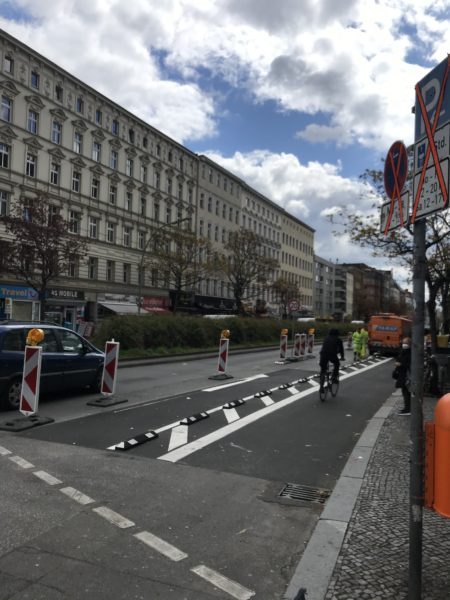
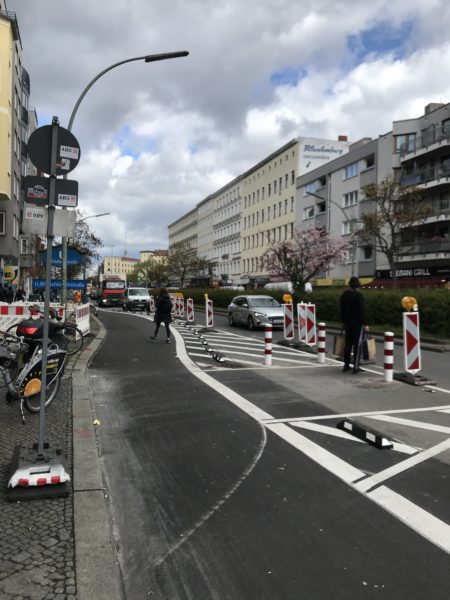
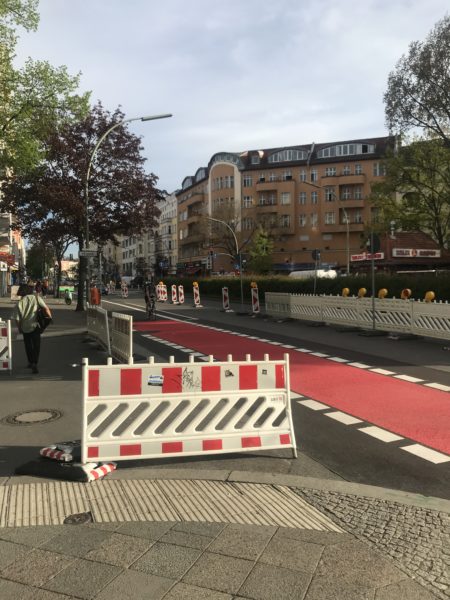
Cities around the world are shifting their mould to fit pandemic requirements, and it’s refreshing to see that something can be done both quickly and continue to be developed once in flight. A recently published comparative study of pop-up bike lanes in European cities in the context of Covid-19 claims that this type of intervention resulted in an 11 – 48% increase in numbers of cyclists between March and June 2020, yielding billions of dollars in prospective health benefits (especially if the habits stick). At a cost of €9500 per kilometre (at least in Berlin) these types of interventions represent good value for money.
I will be keeping an eye on the fate of the pop-up radwege in Berlin and will be scoping where it looks as though the temporary measures are being swapped out for permanent ones across the city.

 Processing...
Processing...
10 days from idea to install and $16,000 per kilometre for temporary trials… read it and weep. But what about the 2 year mega buck business cases? What do all the suits there do? How do they fill their days if not lumbering cost and delay onto projects? Crazy Europeans.
Project Wave shows just how quickly you can install cycle lanes that are 90% as effective as a multi million dollar streetscape project at 1% of the cost over the weekend, just by dropping concrete sleepers and painting over the median strip
Job done. If only AT gave a shit
Also:
…the roading authority i.e. the Senate for Environment, Transport and Climate Protection.
Working under that institutional name would concentrate minds somewhat on their actual task.
I think AT would love to do this in Queen St. These red and white plastic sticks and plastic barriers would clash nicely with all the junk they have already put in. This is surely the next step.
There are some great examples of ‘hit sticks’ being converted into advertising, promotions or artworks out there. Simple corflute sleeves would do the trick.
AT’s cycling infrastructure implementation delays are, essentially, all about refusing to reallocate road space; this is the source of AT’s excuses about cost.
Yet Council’s Letter Of Expectation to AT requiring them to boldly reallocate road space to active and public transport modes is now FIVE years old, and the GPS 2018 and GPS 2021 both were absolutely clear about prioritising cycling and safety.
AT may claim the RLTP was hamstrung by the big roads in NZUP, but failing to complete 70% of the Auckland Cycle Network by 2020, as directed by Council in 2012, is of AT’s making.
The good news is that Berlin shows they can still complete 100% of the Auckland Cycle Network by 2025 as Council also directed them to do in 2012.
And at this stage of the process, if the AT Board and CEO don’t know what’s holding this up, they are choosing not to look. And choosing not to ask the people who do know.
The thing about project WAVE, is that it didn’t really need doing. I ride that route most days, with kids in the bike. Market Place and Customs Street West were already fine for cycling. The motor vehicle volumes were low, and the speed limit was already 30km/h. As a cyclist, you could just merge with any traffic that there was. Now, northbound here is a dogleg kink where I’m supposed to stop, and cross to the right to get to the other side of the road where the new cyclelane is. It’s made a convenient cycle route inconvenient and slower.
It seems to me that Auckland Transport can move quickly on cycle lanes where car volumes are low because there will be little objection – but also, where car volumes and speeds are already low, you don’t really need cycle lanes.
The Lower Hobson Street leg is valuable, because that is where motor vehicle volumes are high and car get racey and impatient. I’m pleased they put that in.
Frustrating reading from an Auckland POV.Highlights the missed opportunities here(never let a crisis go to waste).Can only imagine that there was some civic leadership, in getting this done,the lawyers would have definitely said “No”,the engineers would have said “Yes,but”.Civic leader says ,”leave the lawyers to me,get in your trucks and start building,next meeting,next week,to show me the progress”.No public backlash,and now normalized behavior,(Status quo),simple stuff really,just got to have vision and desire.
+1
+1
“This ‘temporary’ quality is intentionally low cost, with a per kilometre cost average in Berlin of €9500 (about NZD$16,000).” Surely that now has to become a target for New Zealand, all over the country. Even / particularly, the Island Bay Cycleway, which is still unfinished, and currently sitting at Million$ per km.
It’s a good approach. Hand out low cost plastic marker posts and fix them to the ground. Leave for a year to iron out the kinks. Replace them where dickhead drivers deliberately break them, move them slightly if they are genuinely in the way. A year later, make them permanent.
What’s the per km cost for something similar in Auckland?
I think there needs to be some law changes so that small changes under a certain amount of money can be done by AT/councils without consultation / legal suits / etc. The fact that a council has to consult before creating a cycleway or reducing a speed limit is just plain crazy. This is meant to be a democracy; if the majority don’t like the changes and they didn’t cost much then they can vote to put it back how it was.
Completely agree, otherwise what is the point of elections. Just make every decision and binding referendum.
Project WAVE has shown how easily we can build quick, attractive and safe cycleways whilst always helping control traffic flow. Shame it had to come from a different fund than what was already allocated to it. Next step for that area is make better use of the parking bays that are no longer used.
Good article, thanks for sharing 🙂
Meanwhile back in the day they did with a bit more style
Thanks for sharing, some recognisable spots 🙂
What a disaster! No signals to hold pedestrians back, people just crossing wherever they felt like it, those poor drivers having to go so slow to make sure they didn’t hit anyone and where is all the parking. How utterly unpleasant and uncivilized. The businesses must have really suffered.
Lol. Yes, the lack of economic activity is so apparent.
Must have really been a struggle!
Watch the video – at about the 2:40 spot onwards, there is the world’s most perfect cycleway. Raised kerbs, twin rows of splendid deciduous trees, separate from the road and separate from the footpath (and man walking with barrow ) – is that not the perfect example of Cycle heaven? Rad wege indeed!
Yep, you’re right.
Great article. Thanks, Ella.
Such a sensible idea. Why is it so hard to execute?